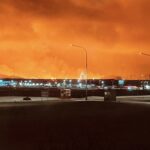A volcanic eruption has begun in the southwest of Iceland, sending fountains of molten lava hundreds of feet up into the sky.
At risk are an evacuated fishing town to the south of the site, a power plant and the country’s main tourist attraction, Blue Lagoon spa, to the west. An eruption has been expected since late October, though the area experienced several weeks of relative calm before lava began flowing at 10:17 p.m. local time on Monday.
Flights are currently operating at the main international airport, Keflavik. An airline advisory states that “a volcanic eruption is underway with no or minor ash emission.”
The crack on the earth’s crust measured about 4 kilometers (2.5 miles) by morning, with eruptions happening along the entire length, the Meteorological Office wrote on its website after surveying the area. By the afternoon, it said that lava flows had decreased to about a quarter of what they were in the beginning, spanning about a third of the fissure, local broadcaster RUV reported.
The site is on the Reykjanes Peninsula, about 40 kilometers southwest of the capital. The volcanic peninsula had been dormant for almost 800 years until early 2020, when intense seismic activity started. Lava rose to the surface in 2021, then emerged again in August 2022 and in July of this year. The eruption that began Monday is the most forceful of these recent ones.

The volcano is near Grindavik, a fishing town of about 3,700 inhabitants that was evacuated in early November following earthquakes that ripped open streets and destroyed infrastructure. Lava is not currently flowing toward the town, according to RUV.
“The lava is still flowing in a remote area away from infrastructure,” Freysteinn Sigmundsson, geophysicist at the University of Iceland, said by phone. “The eruption is evolving and its vigor is declining. There is less magma flow coming to the surface and the eruptive activity is localizing more on a set of craters.”
“In these eruptions, it’s quite typical that they have the most power initially and then decline rapidly and this seems to be following that pattern,” he said.
Initially lava fountains were estimated to reach higher than 100 meters (330 feet). Determining where lava will flow, and eventually pool, will require further assessment over the coming days, Sigmundsson said.
The lava flows seen prior to Monday’s rupture were fissure eruptions that did not produce ash and which were located further away from inhabited areas and infrastructure. Eruptions that extend into the sea are more likely to become explosive and to generate ash that could halt air traffic.
In 2010, volcano Eyjafjallajokull in the southern part of the country released a vast plume of ash that grounded air traffic across Europe for weeks. Air regulations have since changed, making any interruption less likely to be as widespread as in 2010.
Iceland, which has 30 volcanic systems and more than 600 hot springs, is one of the most geologically active places on earth, due to its position on the mid-Atlantic ridge between the North American and Eurasian tectonic plates.
Though eruptions aren’t rare, there has not been a volcanic event that threatens inhabited areas at this scale since an eruption in 1973 buried part of a 5,000-person town in the Westman Islands under lava.
The reaction from the FX market has been muted, with the krona little changed. Icelandair Group hf rose as much as 3.8% and Fly Play hf gained 4.7%.
For the travel industry, the events are both a risk and an opportunity.
“The coming days and weeks are the main booking period for next year’s high season,” Johannes Thor Skulason, managing director of the Icelandic Travel Industry Association, said by phone. “We have seen in the last years that eruptions always get a lot of attention and it can both deter and attract people.”
The volcano currently erupting is close to Iceland’s biggest tourist attraction, the Blue Lagoon spa, as well as the Svartsengi power plant, which is owned by HS Orka hf and which provides heat to about 30,000 inhabitants of peninsula and other businesses centered around geothermal heat. Authorities have sought to protect those sites by building ramparts, which had been nearing completion when the eruption began.
The power plant is generating power normally, a spokesperson said by phone, adding that it’s operated remotely with no staff on site. The Blue Lagoon is closed, having just reopened some services on Sunday.
Top photo: Smoke billows above Keflavik on the Reykjanes peninsula on Dec. 18. Photographer: Maria Steinunn Johannesdottir/Getty Images
Was this article valuable?
Here are more articles you may enjoy.

 US Lawmaker Unveils Bill Requiring Manual Car-Door Releases
US Lawmaker Unveils Bill Requiring Manual Car-Door Releases  California Governor Seeks $200M to Replace EV Tax Credits Cut by Trump
California Governor Seeks $200M to Replace EV Tax Credits Cut by Trump  What The Return of California’s ‘Death Discount’ Means for Litigation
What The Return of California’s ‘Death Discount’ Means for Litigation  Storm Goretti Batters Europe With Violent Winds, Power Cuts
Storm Goretti Batters Europe With Violent Winds, Power Cuts 